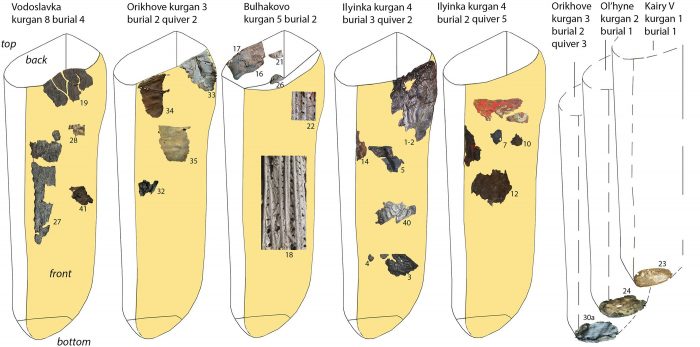From a letter opener fashioned with a Japanese WWII soldier’s arm bone to 200 Philistine foreskins, claiming human remains as war trophies is a grisly but well-entrenched practice. Soldiers have committed unspeakable atrocities against their counterparts in service to these traditions for millennia.
Add another notch on the belt — but don’t think too hard about what it’s made of.
Since the time of Greek historian Herodotus, a rumor circulated that ancient Scythians stretched the skin of their dead enemies over new arrow quivers. A new study led by the University of Copenhagen gives it credence.
“Scythians primarily used domesticated species such as sheep, goat, cattle, and horse for the production of leather, while the furs were made of wild animals such as fox, squirrel and feline species,” reads the study, published in the journal Plos One.

Each sample likely came from a different area on various quivers. Samples 7 and 21 are likely human. Photo: Brandt et al
“The surprise discovery is the presence of two human skin samples, which for the first time provide direct evidence of the ancient Greek historian Herodotus’ claim that Scythians used the skin of their dead enemies to manufacture leather trophy items.”
The study delves into the Scythians’ extensive leather-processing techniques, which it calls “sophisticated.” The researchers observe that a culture’s choice in animal hide divulges nuances about its character.
“It not only provides insights into the range of animal species utilized but also reveals choices made in leather production, the functionality and appearance of the leather, and potentially even specific beliefs associated with the objects,” the authors wrote.
The Scythians were genetically diverse, nomadic, and roamed the Eurasian steppes during the first millennium BC. High-profile excavations of Scythian graves have turned up gold objects and coveted textiles. Resulting narratives, the Copenhagen researchers argue, have glossed over the peoples’ more utilitarian needs.
Their daily lives demanded “a steady supply” of basic raw materials, like wood, bone, and leather.

A pie chart showing the origin of the 45 tested samples. Image: Brandt et. al
The team focused on leather largely because it usually degrades quickly and so has been hard to study in the past. The 45 leather samples came from 13 different Scythian sites in Ukraine, primarily from the fourth century BC.

Study area. Image: Brandt et. al
Results from two of them strongly indicate human origin.
Herodotus didn’t pay strict duty to the truth on every topic he breached. But the test results support at least one of his “grizzly claims” about the Scythians.
“A Scythian drinks the blood of the first man whom he has taken down. He scalps the head by making a cut around it by the ears, then grasping the scalp and shaking the head off. Many Scythians even make garments to wear out of these scalps, sewing them together like coats of skin. Many too take off the skin, nails and all, from their dead enemies’ right hands, and make coverings for their quivers,” he wrote in Histories.
View this post on Instagram
Whether the samples originated from the Scythians’ enemies or their own people remains unclear. The Scythians also had a cultural tendency to ceremonially self-mutilate after the death of a king.






